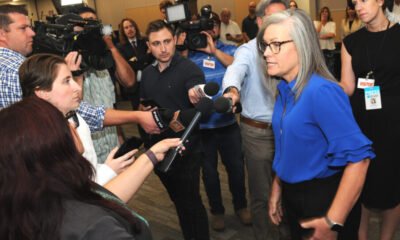Education
Hobbs Slams ESA Program as ‘Billion-Dollar Boondoggle’ and Advocates for Income Caps

Governor Katie Hobbs’ recent proposal to introduce income caps as a measure to regulate the Empowerment Scholarship Account (ESA) program has sparked significant debate in Arizona. The plan emerged during her State of the State Address and has drawn praise from public education advocates while being criticized by school choice supporters.
Proponents argue that income caps are a necessary first step toward addressing the disproportionate distribution of ESA funds, often favoring affluent families over low-income households. Recent studies show that high-income neighborhoods utilize the ESA program at a significantly higher rate, raising concerns about equity in educational funding.
Conversely, critics view Hobbs’ proposal as empty rhetoric, questioning why district and charter schools do not have similar income restrictions. The absence of means testing in these educational avenues is frequently pointed out as a glaring inconsistency in the state’s approach to school funding.
As the executive budget is set for release on January 17, Hobbs’ proposal raises critical questions regarding its implementation and the necessary data collection that would support such a measure. In her address on January 13, she emphasized the need for accountability within the ESA program, claiming it has transformed from a supportive initiative for special needs and military families into an unchecked system open to exploitation.
“The current program is unchecked, flawed, and rife with exploitation,” Hobbs stated. “It has ballooned into a billion-dollar boondoggle.” She also called for transparency in taxpayer spending, highlighting potential misallocation of funds.
Advocates for income caps laud them as common-sense reform, proposing a model where low-income students receive full funding while support diminishes as household income rises. However, implementing such reforms hinges on acquiring accurate income data, which the Department of Education currently lacks.
Research indicates a trend where the wealthier segments of Arizona’s population disproportionately benefit from the ESA program. Data published by the Grand Canyon Institute revealed that, during the program’s expansion, nearly 45% of ESA applicants resided in areas with median household incomes exceeding $80,000.
Further studies have reinforced this narrative, showing that the highest participation in ESA is found in low-poverty regions. Analysts point to a significant gap in resource allocation, whereby affluent families are afforded greater educational choices at the expense of those who genuinely need support.
Matt Beienburg from the Goldwater Institute has criticized Hobbs for recycling previous proposals without substantial change. He argues that unless there is an across-the-board income cap for all K-12 funding, her approach seems inconsistent and lacks thorough justification.
Similarly, Jenny Clark, founder of Love Your School, maintains that any cap on ESA funds must be mirrored by restrictions on public school funding for wealthy families. This aligns with her belief that the current system disproportionately burdens taxpayers without equitable considerations.
As stakeholders eagerly await further details from Hobbs’ executive budget, the conversation surrounding income caps and the future of the ESA program continues to evolve. The impending release may clarify the Governor’s stance and outline a potential pathway toward more equitable educational funding in Arizona.


















